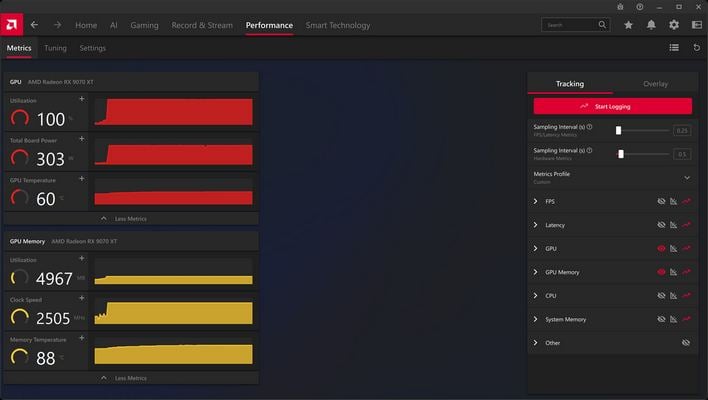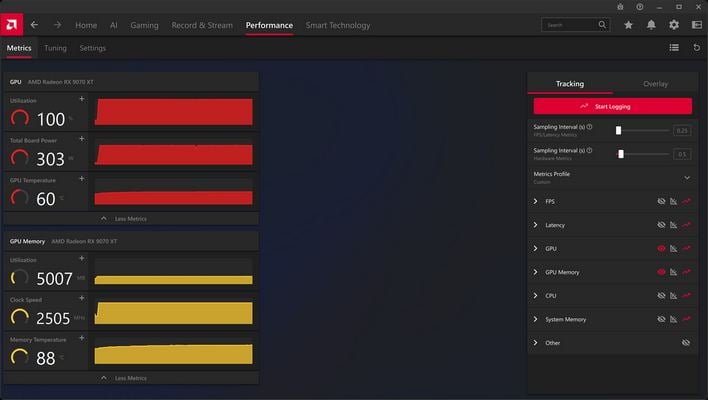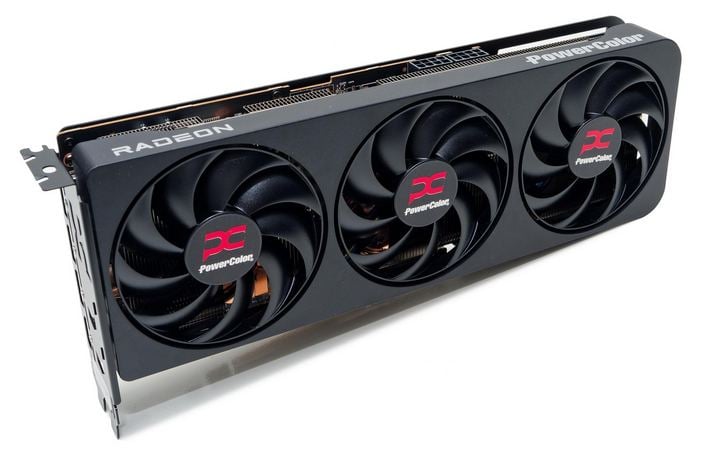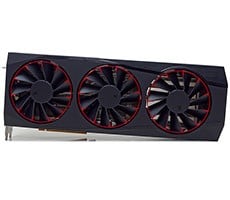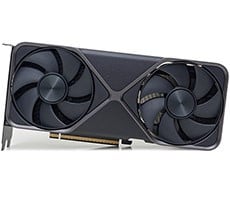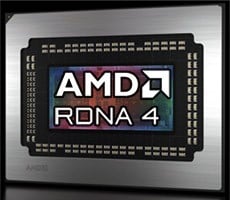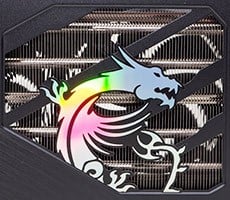AMD Radeon RX 9070 XT And 9070 Review: Competition Heats-Up For Gamers
Similar to previous-gen Radeons, when the GPU is boosting, frequencies and voltages dynamically scale up or down based on the GPU's workload and temperatures at the time. That frequency and voltage curve can be altered to increase performance, save power, or sometimes both if you tune the settings accordingly.
The tuning options built into AMD's driver suite give users the ability to manually alter frequencies, voltages, fan speeds, and the max power target -- using percentages or finer-grained numerical sliders. Users can also opt to use various preset modes that slant the VFC in favor of efficiency or higher performance. At this time, however, the press driver for the Radeon RX 9070 and 9070 XTs didn't report GPU frequencies in the metric section and tuning didn't allow voltage manipulation.
The tuning options built into AMD's Radeon Software suite offer manual controls, along with an automatic GPU overclocking button. The auto memory overclocking button available on previous gen AMD Radeon cards was not present.
As if the case when overclocking any GPU, finding the highest stable memory and GPU clocks, at the lowest voltage possible, while simultaneously increasing the max power target and keeping temperatures low, is what will yield the best overall overclocking results. For now, tweaking voltages is out, but there's still some performance to be had with the remaining options.
At its stock settings, the PowerColor Reaper Radeon 9070 XT's GPU clocks will hove around the 2,400MHz range while gaming (give or take) with maximum boost clocks of approximately 2,970MHz. When running in this stock configuration our card hit a modest GPU temp of 60°C. With some tweaking, we found we could increase the GPU clock offset by 103MHz, with the power target increased by its maximum of 10%. We also tried manually increasing the memory clock, which seemed to function properly and passed the built-in stress test in AMD's drivers, but the control panel wasn't reporting increased memory clocks during testing.
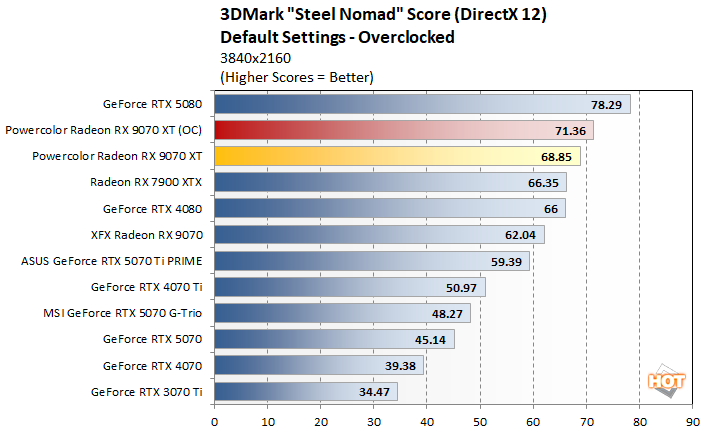
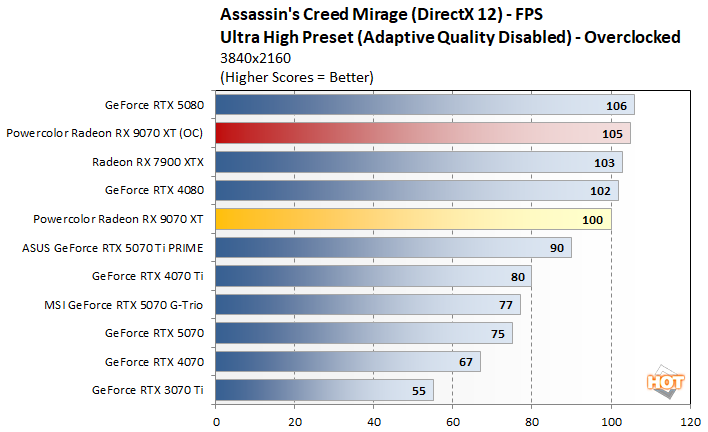
Still, while we had the card overclocked, we re-ran a couple of tests and saw some nice performance gains. In the Steel Nomad benchmark, the Radeon RX 9070 XT inched closer to the GeForce RTX 5080 and in Assassin's Creed Mirage, the 9070 XT was able to overtake the Radeon RX 7900 XTX and GeForce RTX 4080, and nearly catch the GeForce RTX 5080.
Total System Power Consumption Tests
We'd also like to cover a couple of final data points regarding power consumption and acoustics before we wrap up. Throughout all of our benchmarking and testing, we monitored noise output and tracked how much power the test system was consuming using a power meter. Our goal was to give you an idea as to how much power each GPU used while idle and also while under a heavy workload. These power numbers were captured during MLPerf and a Horizon Zero Dawn Remastered run at 4K...
However, despite its considerable power consumption, noise isn't a concern with the Radeon RX 9070 XT, or any of the new Radeons we tested for that matter.. The card's fans are dead silent at idle, because they spin down completely when temperatures are low. In its stock config, the fans typically hovered around 1,500 RPM under long sustained loads, which produced a dull whir that wasn't particularly noticeable over our test system's PSU fans and CPU cooler. And while overclocked, the fans hovered at around 2,200 RPM, which had a minimal impact on noise output. Overall, we'd consider all of the Radeon RX 9070 series cards we tested relatively quiet and noise shouldn't be an issue for most users, especially in a closed chassis.
AMD Radeon RX 9070 Series Performance And Review Summary
NVIDIA’s GeForce RTX 50 series launches have been marred somewhat by lower than expected performance increases, news of melting power connectors on high-end cards, missing support for some legacy features (like 32-bit PhysX, etc.), and street pricing much higher than MSRP. With all of that in mind, gamers were eager for AMD to play its hand, and generally speaking the response to the RDNA 4 and Radeon RX 9070 reveal last week was mostly positive.
Now that we’ve gotten to test the cards ourselves, we think most folks will be happy with RDNA 4 and the Radeon RX 9070 and 9070 XT, especially if cards actually approach MSRP, though it’s not a clear win for AMD. Generally speaking, the Radeon RX 9070 and 9070 XT perform well and are right in the mix with the more expensive GeForce RTX 5070 Ti and RTX 5070. NVIDIA, however, continues to have the edge with ray tracing and in some creator workloads, and the Radeons offered inconsistent performance in some tests – like Procyon AI Text Generation, for example. Power consumption on the Radeon RX 9070 XT is also relatively high, though that's less of a concern for most gamers.
That said, we’re pleasantly surprised by the Radeon RX 9070 and 9070 XT. In some games that are particularly well-tuned to AMD’s architecture, performance is excellent and competitive with much more expensive cards. And where performance isn’t stellar, the Radeon RX 9070 and 9070 XT still remain in the mix and handle taxing workloads (like Cyberpunk or Black Myth: Wukon) better than RDNA 3-based cards.
Even though the company hasn’t announced plans for a halo product to battle at the ultra high-end of the gaming GPU market this generation, AMD appears to be on the right path. The company has plans in place to improve its drivers and software, refining them with the help of AI and tools that enable gamers to better report issues. RDNA 4 addresses some deficiencies in previous gen architectures, and its overall performance is good across many of the latest AAA gaming titles. At their sub-$600 MSRPs, the Radeon RX 9070 and 9070 XT should be popular. Though, the $50 gap separating the 9070 and 9070 XT is too small. If you can swing the extra funds, it makes sense to splurge on the Radeon RX 9070 XT.
Here's hoping street prices actually approach MSRP. As we’ve seen for a couple of generations now, MSRP means very little and street prices have been considerably higher. If we’re strictly considering MSRP, the launch of the Radeon RX 9070 and 9070 XT puts considerable pressure on NVIDIA, and may necessitate some downward price movement on the GeForce RTX 5070 Ti and RTX 5070. But in the real world, street prices matter and we’ll have to wait and see how things shake out. Trump's latest tariffs will certainly affect cards assembled in China, for example.
All things considered though, the launch of the Radeon RX 9070 and 9070 XT is a very good thing for gamers. AMD has a competitive GPU architecture on its hands and the company's target pricing should make the Radeon RX 9070 and Radeon RX 9070 XT very strong options in their respective price brackets.


